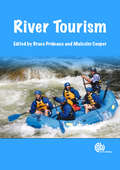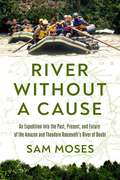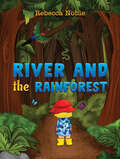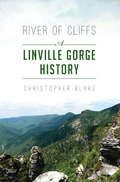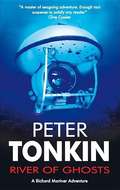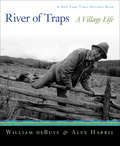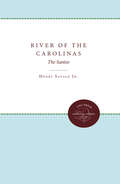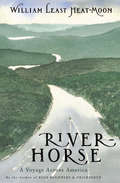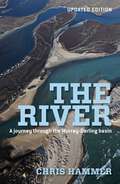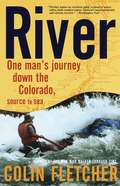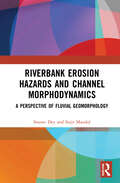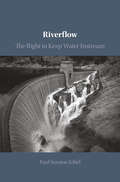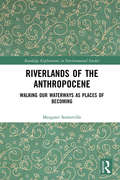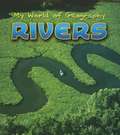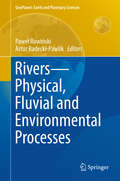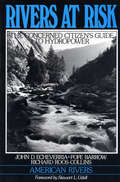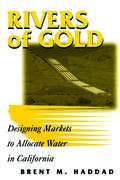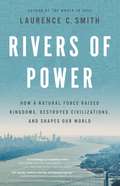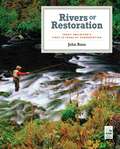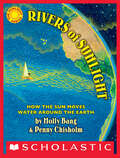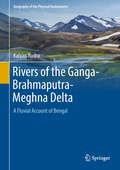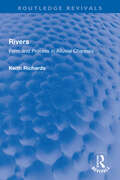- Table View
- List View
River Tourism
by Malcolm Cooper Bruce PrideauxRivers constitute a major tourism resource, providing spectacular settings, recreation facilities, a means of transport, a sense of heritage and adventure, and links with the environment and natural world. River tourism accounts for a significant proportion of the world's tourism consumption, with activities such as Nile cruises and rafting holidays making it an economically important area of tourism demanding in-depth analysis. This book explores river tourism from a range of perspectives including uses, heritage, management, environmental concerns, and marketing.
River Without a Cause: An Expedition through the Past, Present and Future of Theodore Roosevelt's River of Doubt
by Sam MosesA riveting journey down Theodore Roosevelt's "river of doubt" with a diverse crew of adventurers, scientists, and Indigenous leaders who shine light on the past, present, and future of a natural wonder.Sam Moses took part in the adventure of a lifetime when he, along with seventeen men and two women, embarked on the Rio Roosevelt Expedition. They would follow the former president's wake down five-hundred miles of extreme whitewater into the dark heart of the Amazon. The party was guided by two chiefs from the Cinta Larga tribe—the same tribe that stalked Roosevelt&’s expedition in 1914—who, between rapids, tell the story of the tribe&’s own Trail of Tears. After the wildest whitewater is past, Moses travels with the chiefs to their village to witness the massive illegal mahogany logging from their forest, the Roosevelt Indigenous Territory. River Without a Cause puts us in the raft during those heart pounding rapid descents, as we experience the drama, dynamics and disputes between the Bull Moose and his co-leader, Brazil&’s most famous explorer, the rigid Colonel Candido Rondon. As the Amazon stands on the precipiece of hope with the election of a new Brazillian president, River Without a Cause is a moving and galvanzing tale of adventure that is a fitting tribute to this world wonder.
River and the Rainforest
by Rebecca Noble“It’s Rainforest Day! Mum, Dad, wake up, wake up,” squealed River. River loves to explore – do you love to explore too? On a day of adventure with his mum and dad, River explores his favourite place – the rainforest. With colourful birds, slimy reptiles, ancient trees and fluffy pademelons, there’s an abundance of wildlife to be discovered. All whilst Mum and Dad provide encouragement and freedom for River to explore. Put on your gumboots and floppy hat and hike into a magical, misty rainforest to explore the natural world.
River of Cliffs: A Linville Gorge History
by Christopher BlakeLinville Gorge was the first Wilderness Area on the East Coast, approved by Congress in 1964. “The Grand Canyon of the East” was named for William Linville, a member of a party of long hunters in 1766 who fell victim to a Shawnee attack. The difficult terrain made early settlements nearly impossible and logging unprofitable, and it remains one of the few examples of old-growth forest in the Blue Ridge Mountains. Unique rock formations, from Table Rock to the Chimneys, and miles of trails attract thousands of climbers, hikers and adventure seekers each year. In this revised edition, author Christopher Blake draws on American colonial reports, travel writings, diaries, fiction and numerous archival records to weave a narrative fabric of an American treasure.
River of Dust: The Life-Giving Link Between North Africa and the Amazon
by Jilanne HoffmannOver and Under the Rainforest meets This Is How We Do It in A River of Dust—a celebration of global interconnectedness with an environmental lens, at a time when we need it most.I am dust,the dust of North Africa.I connect continents. The dust of the Sahel—a ribbon of land between the Sahara and the savannah—lifts with the harmattan wind each winter season. But this is not just any dust. The Sahel's dust will mix with dust from the Sahara and travel thousands of miles westward, across the African continent and the Atlantic Ocean, to reunite with its unforgotten home deep in the Amazon basin. Told in the perspective of dust, A River of Dust takes readers on a journey through vibrantly illustrated landscapes, celebrating the power and wonder of Earth's ecosystems, and showing how these tiny particles are in fact key to the health of our planet. Meticulously researched and lushly illustrated, this picture book is a lyrical ode to global interconnectedness and the vital roles that even the smallest play in taking care of our planet.GLOBAL CONNECTIVITY: Just like This Is How We Do It, this book emphasizes global connectivity: the Amazon can't succeed by itself, and we all have a role to play.SMALL PARTICLES, MIGHTY IMPACT: This powerful story of the Sahel's very necessary contribution to the world demonstrates how seemingly inconsequential particles are key to the health of our planet. And if dust can be so important, readers will imagine the impact each one of them can have on the world around them.EDUCATIONAL TOOL: With strong STEM themes, this offers plenty of opportunities to incorporate into lesson plans, from units on geography and environmental science, particularly lessons on the rainforest, global warming, and interconnected ecosystems.SOOTHING LULLABY: Poetic and yearning, this picture book has a gentle message that reassures its readers about remaining connected despite time and distance with an affirmation of love that parents will enjoy sharing with their children.ARTFUL & LUSH: Vivid landscapes, from the deserts of Africa to the rainforests of the Amazon, by illustrator Eugenia Mello, make this lyrical picture book come to life. Note the gorgeous spattering of foil dust on the jacket, which makes this cover glow!WANT TO LEARN MORE?: Meticulously researched information included at the back of the book provides insight and compelling scientific facts for readers who are curious to know more. Did you know that there are more trees in the Amazon than stars in the Milky Way galaxy?Perfect for:Resource for teachers and librarians seeking books about nature, the earth, and ecology for kidsParents looking for non-fiction picture books and science books for childrenA beautiful environmental picture book and lyrical story for anyone interested in learning about ecosystems and the environmentFans of Over and Under the Rainforest, Over and Under the Pond, and other popular nature books for young readers
River of Ghosts (Richard Mariner Adventure #20)
by Peter TonkinDeep in the darkest reaches of the East China Sea, the remote vessel Neptune edges through the utter blackness along the Ryuku Trench, guided by the steady hands of Richard and Robin Mariner. The Mariners are actually five thousand metres above Neptune. They are seated side by side in the virtual environment presented by the vehicle control room of Poseidon, testing their company Heritage Mariner's latest acquisition. Suddenly a distress call comes in. A submarine has become trapped on the seabed nearby and its crew are rapidly running out of air. The trapped submarine has been on news networks for the last few days as its widely publicized mission is to recover a fortune in gold lost aboard the greatest of Kublai Khan's huge treasure ships, which sailed for Japan in 1281 and vanished without trace. But as the Mariners and their associates guide Neptune to the rescue of the submariners trapped far below, a different, darker, story becomes plain. Was the submarine's voyage simply a cover for another, more sinister, mission?
River of Traps
by Alex Harris William DebuysNew Mexico's Sangre de Cristo mountains are a place where two cultures - Hispanic and Anglo - meet. They're also the place where three men meet: William deBuys, a young writer; Alex Harris, a young photographer; and Jacobo Romero, an old farmer. When Harris and deBuys move to New Mexico in the 1970s, Romero is the neighbor who befriends them and becomes their teacher. With the tools of simple labor - shovel and axe, irony and humor - he shows them how to survive, even flourish, in their isolated village. A remarkable look at modern life in the mountains, River of Traps also magically evokes the now-vanished world in which Romero tended flocks on frontier ranges and absorbed the values of a society untouched by cash or Anglo America. His memories and wisdom, shared without sentimentality, permeate this absorbing story of three men and the place that forever shaped their lives.
River of the Carolinas: The Santee
by Henry SavageThe story of the Santee is, in fact, the story of a major part of the Carolinas east of the Appalachians, for the river drains an immense area of both states from the mountains to the ocean. Savage also describes fully the change-over from the agricultural Old South to the industrial New South, a change sparked largely by the hydroelectric power of the Santee.Originally published in 1968.A UNC Press Enduring Edition -- UNC Press Enduring Editions use the latest in digital technology to make available again books from our distinguished backlist that were previously out of print. These editions are published unaltered from the original, and are presented in affordable paperback formats, bringing readers both historical and cultural value.
River of the Sacred Monkey
by Dimitar KrustevAn authentic chronicle of wilderness river exploration in Central America, with a valid portrayal of the last remaining descendants of the vanishing Mayans.
River-Horse: A Voyage Across America (Core Ser.)
by William Least Heat-MoonNew York Times bestseller: &“A coast-to-coast journey by way of great rivers, conducted by a contemporary master of travel writing&” (Kirkus Reviews). In this memoir brimming with history, humor, and wisdom, the author of Blue Highways and PrairyErth &“voyages across the country, from Atlantic to Pacific, almost entirely by its rivers, lakes and canals in a small outboard-powered boat&” (San Francisco Chronicle). Setting off from New York Harbor aboard the boat he named Nikawa (&“river horse&” in Osage), in hopes of entering the Pacific near Astoria, Oregon, William Least Heat-Moon and his companion, Pilotis, struggle to cover some five thousand watery miles—more than any other cross-country river traveler has ever managed—often following in the wakes of our most famous explorers, from Henry Hudson to Lewis and Clark. En route, the voyagers confront massive floods, submerged rocks, dangerous weather, and their own doubts about whether they can complete the trip. But the hard days yield incomparable pleasures: strangers generous with help and eccentric tales, landscapes unchanged since Sacagawea saw them, riverscapes flowing with a lively past, and the growing belief that efforts to protect our lands and waters are beginning to pay off. &“Fizzes with intelligence and high spirits.&” —Outside &“Propels the reader with historical vignettes, ecological and geological detail, and often hilarious encounters with local eccentrics.&” —Time
River: A Journey Through The Murray-Darling Basin
by Chris HammerIn The River, Chris Hammer takes us on a journey through Australia's heartland, following the rivers of the Murray-Darling Basin, recounting his experiences, his impressions, and, above all, stories of the people he meets along the way. It's a journey punctuated with laughter, sadness and reflection. The River looks past the daily news reports and their sterile statistics, revealing the true impact of our rivers' decline on the people who live along their shores, and on the country as a whole. It's a tale that leaves the reader with a lingering sense of nostalgia for an Australia that may be fading away forever.
River: One Man's Journey Down the Colorado, Source to Sea (Vintage Departures)
by Colin FletcherAt age sixty-seven, Colin Fletcher, the guru of backpacking in America, undertook a rigorous six-month raft expedition down the full length of the Colorado River--alone. He needed "something to pare the fat off my soul. . . to make me grateful, again, for being alive. " The 1,700 miles between the Colorado's source in Wyoming and its conclusion at Mexico's Gulf of California contain some of the most spectacular vistas on earth, and Fletcher is the ideal guide for the terrain. As his privileged companions, we travel to places like Disaster Falls and Desolation Canyon, observe beaver and elk, experience sandstorms and whitewater rapids, and share Fletcher's thoughts on the human race, the environment, and the joys of solitude.
Riverbank Erosion Hazards and Channel Morphodynamics: A Perspective of Fluvial Geomorphology
by Sujit Mandal Sourav DeyThis book explores fluvial processes and their consequences on river dynamics in India. It discusses the integration of geomorphic, hydrologic, and socio-economic data with various policies and decisions regarding sustainable river basin management. The volume looks at the origin and development of streams, chronology of fluvial geomorphology, fluvial system concept, process–form interaction, river dynamics, channel migration, flow regime, channel types, and hydraulic and morphometric parameters; and explains how changing hydro-geomorphological dynamics have influenced land use patterns, nature of fluids, behaviour of floods, etc. It examines channel migration vulnerability and bank erosion hazard vulnerability of the Torsa River in the eastern region of India as a case study using channel migration zone and Bank Erosion Hazard Index models. The book presents a new research framework based on field surveys, scientific investigations, and analytical techniques and methods to interpret key geoinformatics data. With its extensive illustrations, this book will be useful to students, teachers, and researchers of geography, earth sciences, environmental geology, and environment and disaster management. It will also interest geographers, civil engineers, hydrologists, geomorphologists, planners, and other individuals and organizations working on fluvial processes and riverbank erosion problems globally.
Riverflow: The Right to Keep Water Instream
by Paul Stanton KibelThere are many people and places connected to rivers: fishermen whose livelihood depends on river ecosystems, farms that need irrigation, indigenous groups whose cultures rely on fish and flowing waters, cities whose electricity comes from hydroelectric dams, and citizens who seek wild nature. For all of these people, instream flow is vitally important to where and how they live and work. Riverflow reveals the diverse and creative ways people are using the law to restore rivers, from the Columbia, Colorado, Klamath and Sacramento–San Joaquin watersheds in America, to the watersheds of the Tweed in England and Scotland, the Fraser in Canada, the Saru in Japan, the Nile in North Africa, and the Tigris–Euphrates in the Middle East. Riverflow documents that we already have the legal tools to preserve the ecological integrity of our waterways; the question is whether we have the political will to deploy these tools effectively.
Riverlands of the Anthropocene: Walking Our Waterways as Places of Becoming (Routledge Explorations in Environmental Studies)
by Margaret SomervilleThis is an invitation to readers to ponder universal questions about human relations with rivers and water for the precarious times of the Anthropocene. The book asks how humans can learn through sensory embodied encounters with local waterways that shape the architecture of cities and make global connections with environments everywhere. The book considers human becomings with urban waterways to address some of the major conceptual challenges of the Anthropocene, through stories of trauma and healing, environmental activism, and encounters with the living beings that inhabit waterways. Its unique contribution is to bring together Australian Aboriginal knowledges with contemporary western, new materialist, posthuman and Deleuzean philosophies, foregrounding how visual, creative and artistic forms can assist us in thinking beyond the constraints of western thought to enable other modes of being and knowing the world for an unpredictable future. Riverlands of the Anthropocene will be of particular interest to those studying the Anthropocene through the lenses of environmental humanities, environmental education, philosophy, ecofeminism and cultural studies.
Rivers (My World of Geography)
by Angela RoystonWhat is the source of a river? How can you travel on a river? How can you help protect rivers? Read this book to find out all about rivers!
Rivers - Physical, Fluvial and Environmental Processes
by Paweł Rowiński Artur Radecki-PawlikThis book describes the domain of research and investigation of physical, chemical and biological attributes of flowing water, and it deals with a cross-disciplinary field of study combining physical, geophysical, hydraulic, technological, environmental interests. It aims to equip engineers, geophysicists, managers working in water-related arenas as well as advanced students and researchers with the most up to date information available on the state of knowledge about rivers, particularly their physical, fluvial and environmental processes. Information from various but also interrelated areas available in one volume is the main benefit for potential readers. All chapters are prepared by leading experts from the leading research laboratories from all over the world.
Rivers at Risk: Concerned Citizen's Guide To Hydropower
by Richard Roos-Collins John Echeverria Pope Barrow American RiversRivers at Risk is an invaluable handbook that offers a practical understanding of how to influence government decisions about hydropower development on America's rivers.
Rivers of Empire: Water, Aridity, and the Growth of the American West
by Donald WorsterWhen Henry David Thoreau went for his daily walk, he would consult his instincts on which direction to follow. More often than not his inner compass pointed west or southwest. "The future lies that way to me," he explained, "and the earth seems more unexhausted and richer on that side. " In his own imaginative way, Thoreau was imitating the countless young pioneers, prospectors, and entrepreneurs who were zealously following Horace Greeley's famous advice to "go west. " Yet while the epic chapter in American history opened by these adventurous men and women is filled with stories of frontier hardship, we rarely think of one of their greatest problems--the lack of water resources. And the same difficulty that made life so troublesome for early settlers remains one of the most pressing concerns in the western states of the late-twentieth century. The American West, blessed with an abundance of earth and sky but cursed with a scarcity of life's most fundamental need, has long dreamed of harnessing all its rivers to produce unlimited wealth and power. In Rivers of Empire, award-winning historian Donald Worster tells the story of this dream and its outcome. He shows how, beginning in the mid-nineteenth century, Mormons were the first attempting to make that dream a reality, damming and diverting rivers to irrigate their land. He follows this intriguing history through the 1930s, when the federal government built hundreds of dams on every major western river, thereby laying the foundation for the cities and farms, money and power of today's West. Yet while these cities have become paradigms of modern American urban centers, and the farms successful high-tech enterprises, Worster reminds us that the costs have been extremely high. Along with the wealth has come massive ecological damage, a redistribution of power to bureaucratic and economic elites, and a class conflict still on the upswing. As a result, the future of this "hydraulic West" is increasingly uncertain, as water continues to be a scarce resource, inadequate to the demand, and declining in quality. Rivers of Empire represents a radically new vision of the American West and its historical significance. Showing how ecological change is inextricably intertwined with social evolution, and reevaluating the old mythic and celebratory approach to the development of the West, Worster offers the most probing, critical analysis of the region to date. He shows how the vast region encompassing our western states, while founded essentially as colonies, have since become the true seat of the American "Empire. " How this imperial West rose out of desert, how it altered the course of nature there, and what it has meant for Thoreau's (and our own) mythic search for freedom and the American Dream, are the central themes of this eloquent and thought-provoking story--a story that begins and ends with water.
Rivers of Gold: Designing Markets To Allocate Water In California
by Brent M. HaddadThe movement to implement market-based approaches to allocating water is gaining ground across California and in other western states. Proponents argue that markets offer an efficient and cost-effective means of promoting conservation -- those who need water would pay for it on the open market, while others would conserve rather than pay increased prices.Rivers of Gold takes a new look at California's water-reallocation challenge. The author explains the concept of water markets and the economic theory undergirding them. He shows how some water markets have worked -- and others have failed -- and gives the reader the analytic tools necessary to understand why. The book: provides an overview of water-supply issues in California compares the situation in California with that of other western states considers the different property rights regimes governing current use and their fit with water market institutions explains how water markets would work and their benefits and drawbacks as an allocation mechanism presents a series of case studies of water markets currently in effect in California offers a list of principles for water market designRivers of Gold offers a balanced understanding of both the role that markets can play in reallocating water and the limitations of the market mechanism. In the end, the author offers a comprehensive assessment of the institutional design features that any water market should incorporate if it is to reallocate water effectively, in California or in any other region where water is scarce.Rivers of Gold is the first book to provide a detailed examination of water markets and the institutional design issues associated with them. It is the only book available that presents in-depth case studies of actual water-market transactions, and will be essential reading for water resource professionals and resource economists, as well as for students and scholars of environmental policy, environmental economics, and resource economics.
Rivers of Power: How a Natural Force Raised Kingdoms, Destroyed Civilizations, and Shapes Our World
by Laurence C. SmithAn "eye-opening, sometimes alarming, and ultimately inspiring" natural history of rivers and their complex and ancient relationship with human civilization (Elizabeth Kolbert, Pulitzer Prize-winning author of The Sixth Extinction).Rivers, more than any road, technology, or political leader, have shaped the course of human civilization. They have opened frontiers, founded cities, settled borders, and fed billions. They promote life, forge peace, grant power, and can capriciously destroy everything in their path. Even today, rivers remain a powerful global force -- one that is more critical than ever to our future.In Rivers of Power, geographer Laurence C. Smith explores the timeless yet underappreciated relationship between rivers and civilization as we know it. Rivers are of course important in many practical ways (water supply, transportation, sanitation, etc). But the full breadth of their influence on the way we live is less obvious. Rivers define and transcend international borders, forcing cooperation between nations. Huge volumes of river water are used to produce energy, raw commodities, and food. Wars, politics, and demography are transformed by their devastating floods. The territorial claims of nations, their cultural and economic ties to each other, and the migrations and histories of their peoples trace back to rivers, river valleys, and the topographic divides they carve upon the world. And as climate change, technology, and cities transform our relationship with nature, new opportunities are arising to protect the waters that sustain us.Beautifully told and expansive in scope, Rivers of Power reveals how and why rivers have so profoundly influenced our civilization and examines the importance this vast, arterial power holds for the future of humanity."As fascinating as it is beautifully written."---Jared Diamond, Pulitzer Prize-winning author of Guns, Germs, and Steel, Collapse, and Upheaval
Rivers of Restoration: Trout Unlimited's First 50 Years of Conservation
by John RossA beautiful tribute to twenty rivers restored by the work of Trout Unlimited and its members. We all love rivers and the trout that the best of them hold. For fifty years, the volunteers of Trout Unlimited have strived to restore, sustain, and preserve the nation's trout and salmon waters. Weaving together human and natural histories, Ross tells the stories of twenty watersheds where Trout Unlimited has labored to save rivers damaged by human shortsightedness. From Michigan's Au Sable to New York's Delaware to rivers in California, Washington, and more, the stories of these rivers-both in peril and in recovery-will remind fishermen why they love the sound of running water, and why our natural resources need to be protected. 200 color photographs.
Rivers of Sunlight: How the Sun Moves Water Around the Earth
by Molly Bang Penny ChisholmThree-time Caldecott Honor Artist Molly Bang and National Science Award-winning professor Penny Chisholm present a stunning, accessible explanation of the Earth's water cycle and its global effects.With stunning artwork and compelling scientific explanation, Bang and Chisholm have brought forth a masterpiece that is critically relevant in this environmentally tumultuous time. How does the sun keep ocean currents moving and lift fresh water from the seas? What can we do to conserve one of our planet's most precious resources? In this newest book in the award-winning Sunlight Series, readers learn about the constant movement of water as it flows around the Earth. As the water changes between liquid, vapor, and ice, Sunlight powers all living things, ensuring that life can exist on Earth.Perfect for any reader--young or old!--this is an invaluable addition to all classrooms, libraries, and at-home collections.
Rivers of the Ganga-Brahmaputra-Meghna Delta: A Fluvial Account Of Bengal (Geography of the Physical Environment)
by Kalyan RudraThis is the first comprehensive book on the rivers of the Ganga-Brahmaputra-Meghna delta. This volume covers all aspects of this highly populated region including land conflicts and environmental impacts such as the Indo-Bangladesh conflict over sharing of trans-boundary water. This book addresses the topic from a highly interdisciplinary perspective covering areas of geography, geology, environment, history, archaeology, sociology and politics of the Bengal region.The book appeals to a wide range of audiences from India, Bangladesh and the international community. The style of presentation makes it easily suitable for students, researchers and interested laymen.
Rivers: Form and Process in Alluvial Channels (Routledge Revivals)
by Keith RichardsOriginally published in 1982, this book presents a detailed review of alluvial river form and process and integrates the distinct but related approaches of geomorphologists, geologists and engineers to the subject. It outlines the environmental catchment factors that control the development of channel equilibrium and provides a detailed account of the sediment transport processes that represent the physical mechanisms by which channel adjustment occurs. Where possible it evaluates theoretical analyses in the context of the empirical evidence. Rivers should prove a valuable textbook for geomorphology students on advanced undergraduate courses on river behaviour and will also be of interest to students of hydraulics and sedimentology and to those concerned with civil and environmental engineering, river management and channel design, maintenance and management in the water industry
